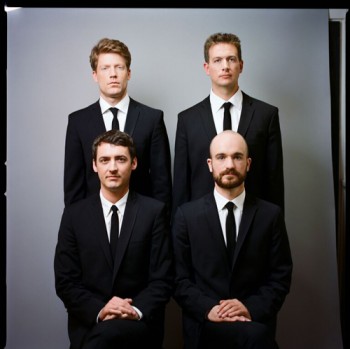by Mike Telin

“We’re excited to see everybody again,” violinist Andrew Bulbrook said during a telephone interview. “It’s been nice to have had both of these opportunities.”
Thursday’s sold-out concert will begin with Swedish composer Anders Hillborg’s Kongsgaard Variations, a work Bulbrook said appeals to people on many levels. “It’s a beautiful piece, and it references the Arietta theme from Beethoven’s final piano sonata. Years ago we went to Stockholm with Thomas Adès, and that’s when Anders was first put on our radar. I don’t think there are a lot of quartets touring his music in the U.S. at the moment.”
The evening will also feature Beethoven’s monumental String Quartet No. 14 in c-sharp, Op. 131. After hearing a performance of the work, Schubert famously remarked, “After this, what is left for us to write?”
“I remember the first time I heard it, I found it challenging, but I was kind of young,” Bulbrook recalled. “It’s written in seven continuous movements, and for the listener it’s an interesting experience because it affects your sense of time — the needle drops, and 40 minutes later it’s over. It’s also not a piece that you can easily follow — if you don’t know it, you can’t say, ‘Oh, we just finished the second movement.’”
Bulbrook said that as he has studied the piece more, he has come to realize that Op. 131 is what makes Beethoven such a great composer of string quartets. “It is the pinnacle of the string quartet structure. You go back to Haydn — he synthesized the four instruments to emulate the boys choir that he had grown up in, and created this perfect four-part string ensemble. Then you have Haydn’s mentoring of Mozart and the development of the quartet with Mozart’s works. Then you end up with Beethoven’s Op. 131, which feels so far removed from what came before it. If you really get inside the piece you can find the same structure, but Beethoven has abstracted it enough that it’s there and not there at the same time. I think that is what makes it such a powerful, monumental work.”
The violinist compared Op. 131 to a well-written story with the action unfolding in front of the listener. “The piece has a beautiful sense of looking both forward and backward. As you get into his later quartets they’re recalling things that have already happened as much as creating them in the present. That’s a beautiful thing in this quartet because structurally it’s so advanced.”
Regarding the fourth movement’s extravagant title (Andante ma non troppo e molto cantabile – Più mosso – Andante moderato e lusinghiero – Adagio – Allegretto – Adagio, ma non troppo e semplice – Allegretto), Bulbrook said, “It’s really a theme and variations. The thematic material is all shaded a little differently through pacing and different rhythmic and textural elements — although the variations here are less clear than in his earlier works, or in the way that Haydn would have approached that structure.”
The Calders are currently in their first year of performing the complete cycle of Beethoven quartets. “We’re mixing in contemporary pieces, and doing some commissioning as part of the project,” Bulbrook said. “We’ve wanted to do this for a long time because Beethoven has been an important part of our development since we got together 18 years ago. His music is mentally intense, and performing a program with two of his quartets on it as compared to one is kind of amazing. It stimulates your brain differently as a performer.”
Hopefully the Calders will return to Cleveland in the near future. In the meantime they’ll continue their residency at the Broad Stage in Santa Monica. Other plans include a project with composer Peter Eötvös and soprano Barbara Hannigan that will take them to London, Paris, Zurich, Madrid, and Frankfurt. “We’re also performing in a Thomas Adès retrospective at Wigmore Hall as well as taking on the long Morton Feldman quartet. And we’re featured on the soundtrack of the movie 10 Cloverfield Lane that was just released. It’s all a lot of fun.”
Published on ClevelandClassical.com March 28, 2016.
Click here for a printable copy of this article



